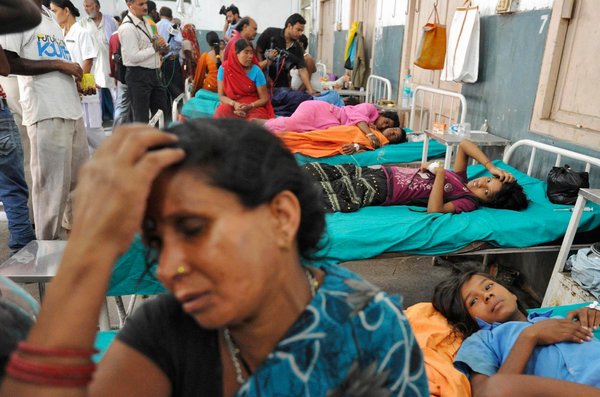25 CHILDREN DIE FROM TAINTED LUNCHES AT INDIAN SCHOOL
Krishna Murari Kishan/Reuters
Asha Devi sat with her daughter, Savita, right, who was sickened by tainted food at her school in the eastern state of Bihar.
By GARDINER HARRIS and HARI KUMAR
NEW DELHI — The children complained that the free lunch at their state
school — rice, beans, potato curry and soy balls — tasted odd. The cook
gave it a taste, too. Within half an hour they all began to suffer
severe stomach pains followed by vomiting and diarrhea, and within hours
at least 22 of the children were dead and dozens of others remained
hospitalized, said officials in the northeastern state of Bihar.
By nightfall on Wednesday, as angry protests broke out, officials said
they believed they had found the cause: cooking oil stored in a
container formerly used for insecticides.
School lunch programs became universal in India after a 2001 order by
the country’s Supreme Court, and free meals are now served to 120
million children — by far the largest such program in the world. It has
been credited with improving school attendance, sometimes substantially.
With some surveys suggesting that nearly half of Indian children suffer
some form of malnutrition, it also serves a vital health purpose.
But like so many government programs in India, it is plagued by
corruption and mismanagement, and cases of tainted food are fairly
routine, although usually nothing like Wednesday’s tragedy.
Also Wednesday, for example, 50 children in a school in the nearby
Madhubani District reported falling ill after eating a school lunch that
some complained contained a dead lizard, though all were sent home from
a nearby clinic after a few hours of observation, said Lokesh Kumar
Singh, the chief civil servant of the district.
While it is still not entirely clear what happened in the village of
Dahrmasati Gandawan in Bihar’s Saran District, some element of cronyism
may have been involved. As news of the tragedy spread, the school’s
principal, who had bought the cooking oil from a store owned by her
husband, disappeared and has not been seen since, officials said.
But it also laid bare the almost complete failure of the state medical
system to deal effectively with the crisis. Parents recounted
nightmarish tales of sickness and desperate efforts to find medical care
in facilities that were rapidly overwhelmed by the sheer numbers of
children affected.
Akilanand Mishra, the father of Ashish Kumar Mishra, 5, said he raced to
the school after a neighbor told him something was wrong there.
“I saw my son walking towards home, and I brought him back home quickly
and took my bike and rushed him to the health center,” Mr. Mishra said
in a telephone interview.
During the trip, Ashish started throwing up, Mr. Mishra said. They
arrived at the nearby primary health center and found it mobbed with
children and families. There was only one doctor, and he began pleading
with parents to take their children to the district government hospital.
Mr. Mishra instead took his son to a nearby private clinic, which was
similarly overrun with patients and panicked parents. By then, Ashish
was suffering near-constant vomiting and diarrhea and was beginning to
lose consciousness, Mr. Mishra said. The doctor (the vast majority of
health care practitioners in India have no formal training whatsoever)
injected the boy with something and insisted that he be taken to the
government hospital.
Instead, Mr. Mishra rushed to another nearby private clinic, which was
also overrun. A government ambulance appeared, but there was no room for
Ashish. So Mr. Mishra flagged down a private vehicle. They set off for
the hospital, but after a few miles Ashish died in Mr. Mishra’s arms.
“My son died around 4 p.m., and he was the second child to die,” said a
weeping Mr. Mishra. “It was poison that the children ate, not food. Food
contamination doesn’t happen that fast. It was poison.”
Bacterial contamination, a common problem in India, generally takes at
least a day to cause serious illness. Caroline Smith DeWaal, director of
food safety for the Center for Science in the Public Interest in Washington, said such episodes tend to happen in places where few things are thrown away, including containers.
“Insecticide containers need to be marked that they should never be used
again for food,” she said. “These kind of incidents are rare, and they
are tragic when they happen.”
www.nytimes.com





Yorumlar